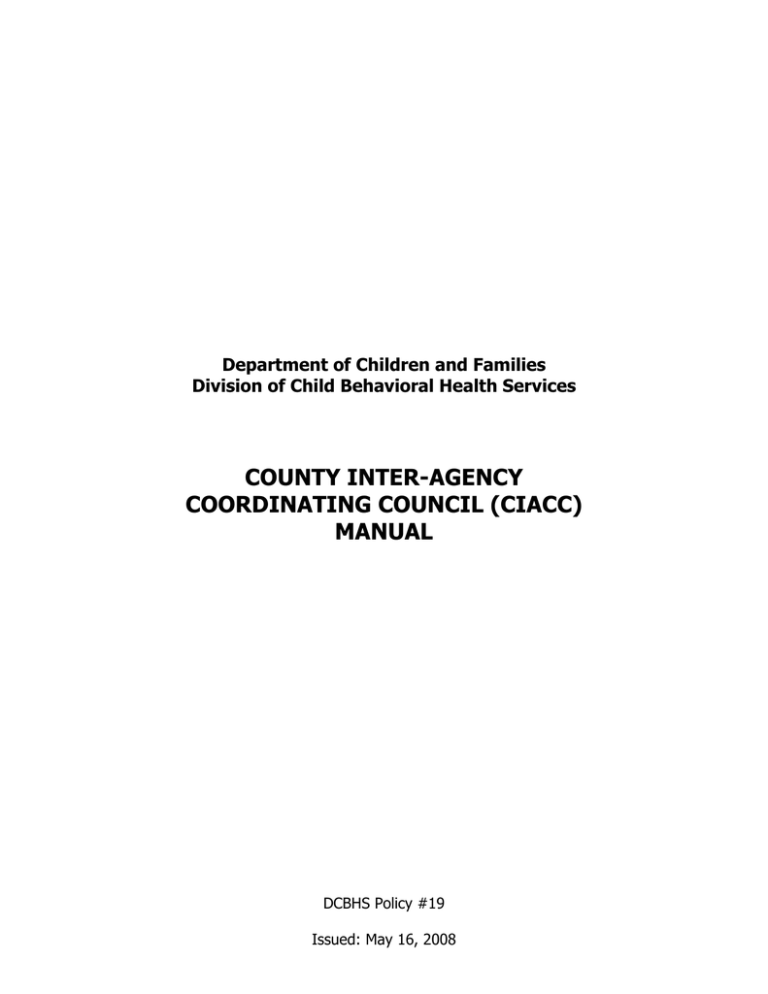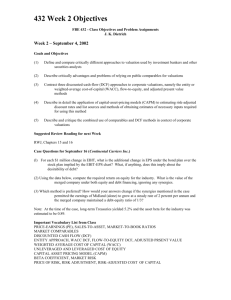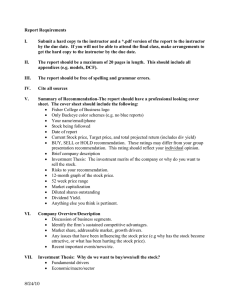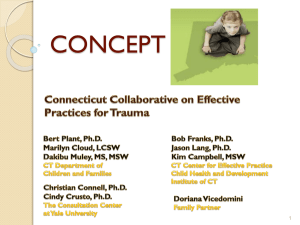COUNTY INTER-AGENCY COORDINATING COUNCIL (CIACC) MANUAL
advertisement

Department of Children and Families Division of Child Behavioral Health Services COUNTY INTER-AGENCY COORDINATING COUNCIL (CIACC) MANUAL DCBHS Policy #19 Issued: May 16, 2008 CIACC MANUAL TABLE OF CONTENTS 1.0 CIACC Role and Functions ----------------------------------- page 3 2.0 Authority ----------------------------------- page 4 3.0 Mission ----------------------------------- page 4 4.0 Population Served ----------------------------------- page 5 5.0 Definitions ----------------------------------- page 5 6.0 Administrative Structure ----------------------------------- page 7 7.0 Composition ----------------------------------- page 7 8.0 Operational Requirements ----------------------------------- page 8 9.0 CIACC Organization ----------------------------------- page 9 10.0 Community Development ----------------------------------- page 9 11.0 Funding Recommendations ----------------------------------- page 10 12.0 Quality Assurance ----------------------------------- page 11 2 1.0 CIACC ROLE AND FUNCTIONS 1.1 The County Inter-Agency Coordinating Council (CIACC) shall perform the following functions: 1.1.1 Serve in an advisory capacity to both county government and Department of Children and Families (DCF). Counties will have flexibility in establishing CIACC within their county government structure providing the CIACC is in compliance with DCF standards and guidelines. 1.1.2 Participate in the Division of Child Behavioral Health Services (DCBHS) quality assurance processes: 1.1.2.1 Receive quality assurance reports from DCBHS on a regular basis and make recommendations to improve service quality and outcomes. 1.1.2.2 Conduct site reviews for CIACC-funded programs and report to DCBHS in a promulgated format. 1.1.3 Participate in cross-system planning at the local level. 1.1.4 Participate in regional or inter-county coordination activities. 1.1.5 Conduct, facilitate and/or identify training and technical assistance needs in coordination with the DCF Child Welfare Training Academy. 1.1.6 Report on CIACC activities in a standardized format on a schedule determined by DCBHS. 1.2 Because of the variety of circumstances at each local level, CIACC shall establish priorities for the activities and work of the CIACC, in partnership with DCF, based on identified need. 1.3 On an annual basis, each CIACC shall submit a County Service Needs Assessment to DCBHS. 1.4 Develop policies and procedures for the inclusion of family voice that demonstrate at least quarterly accommodation to working families and schooling children, youth and young adults. 1.5 The CIACC shall convene a minimum of 10 CIACC meetings per calendar year. 1.6 The County/Convener is represented at monthly Convener meetings. 1.7 As DCF restructures children, youth and young adult services, the role and function of the CIACC may continue to be modified. 3 2.0 AUTHORITY 2.1 3.0 In accordance with N.J.S.A. 30:4C-66 et seq., the County Inter-Agency Coordinating Councils (CIACCs) are advisors to the Department of Children and Families (DCF). As duly constituted advisory groups, they may make recommendations to DCF, while DCF retains the final authority and obligation for decision making. MISSION 3.1 In collaboration with the Department of Children and Families (DCF), the County Inter-Agency Coordinating Council (CIACC) strives to ensure a seamless array of services. The CIACC serves as the county mechanism to advise the DCF on the development and maintenance of a responsive, accessible, and integrated system of care for children, youth and young adults with emotional and behavioral challenges and their families, through the involvement of parents, children, youth and young adults, child-serving agencies, and community representatives. Through enhanced coordination of system partners, the CIACC also identifies service and resource gaps and priorities for resource development. 3.2 The CIACC shall function as the entity that: 3.2.1 Evaluates the local county policies and practices to understand and minimize the impact of local barriers to serving children, youth and young adults with emotional and behavioral challenges in their home community. 3.2.2 Identifies local strategies and mechanisms to promote the integration and coordination of county, State or other resources serving children, youth and young adults with emotional and behavioral challenges. 3.2.3 Assesses local systems needs using information received from DCF, the Contracted Systems Administrator (CSA), any child-serving agency identified by DCF, and other bodies to make recommendations regarding service and resource development priorities. 3.2.4 Identifies and informs DCF regarding gaps and barriers to local service effectiveness. 3.2.5 Provides input to State, regional and county entities regarding system performance and service need. 4 4.0 POPULATION SERVED 4.1 5.0 Target Population 4.1.1 The target population of the CIACC is defined as any child, youth or young adult eligible for DCBHS services whose emotional or behavioral challenges are so pronounced as to cause the child, youth or young adult to have difficulty functioning in their home or community, and whose behavior causes the child, youth or young adult to come to the attention of a private or public institution. 4.1.2 Local counties with concerns regarding special populations within the overall target population may develop local priorities and work plans to address specific needs in collaboration with DCF. DEFINITIONS 5.1 Care Management Organization (CMO). An independent, community-based organization responsible for developing community resources and implementing Individual Service Plans for children, youth and young adults with complex needs and multi-system involvement. See N.J.A.C. 10:73. 5.2 Children’s System of Care. A statewide initiative established for children, youth and young adults with emotional and behavioral challenges. The primary goals are to enhance crosssystem service planning in each county; reduce reliance on institutional care, especially out-of-state residential placements; and to allow for individualized, time-limited, familycentered, least restrictive services. 5.3 Contracted Systems Administrator (CSA). An administrative organization contracted by, and serving as an agent of, the Division of Child Behavioral Health Services to provide utilization management, care coordination, quality management and information management for the statewide system of care which provides mental and behavioral health services and supports to eligible children, youth and young adults. 5.4 County Inter-Agency Coordinating Council (CIACC). The county-based planning and advisory group composed of individuals from government and private agencies that advise the county and the Department of Children and Families regarding children, youth and young adults with serious emotional and behavioral health challenges. 5.5 Department of Children and Families (DCF). Within the executive branch of New Jersey State Government, the Department of Children and Families includes the Division of Youth and Family Services (DYFS), Division of Child Behavioral Health Services (DCBHS), Division of Prevention and Community Partnership, Child Welfare Training Academy and Office of Education. 5 5.6 Division of Child Behavioral Health Services (DCBHS). Division within the Department of Children and Families which provides a comprehensive approach to the provision of mental and behavioral health services to eligible children, youth and young adults. 5.7 Division of Youth and Family Services (DYFS). New Jersey’s child protection and child welfare agency within the Department of Children and Families, whose mission is to ensure the safety, permanency and well-being of children, youth and young adults and to support families. DYFS is responsible for investigating allegations of child abuse and neglect, and if necessary, arranging for the protection of the child, youth or young adult and the family’s treatment. 5.8 Family Support Organization (FSO). An organization under contract with DCF to provide peer support and other services to children, youth and young adults and families as a system partner in the Division of Child Behavioral Health Services. 5.9 Mobile Response Stabilization Services (MRSS). Time-limited, intensive, therapeutic and rehabilitative interventions delivered by or under the auspices of the Mobile Response agency, which includes the initial face-to-face response wherever the need presents and the follow-up coordination of services to address the presenting crisis behavior and prevent disruption of the living situation of the child, youth and young adult. 5.10 Provider. An employee, volunteer or board member of an organization or agency which provides services to children, youth and young adults with special social and emotional needs or other related services for children, youth and young adults, or is believed to provide a valuable contribution to planning for children, youth and young adults with those same needs. 5.11 Unified Care Management (UCM). A community-based organization under contract with DCBHS that combines advocacy, service planning and delivery, and care coordination into a single, integrated, cross-system process, in order to assess, design, implement and manage child centered and family-focused individualized service plans for children, youth and young adults whose needs require either intensive or moderate care management techniques that cross multiple service systems. Under one organization, Unified Care Management entities offer the level of care coordination provided by both the CMO and the YCM. 5.12 Young Adult. An individual at least 18 years of age and under 21, who prior to becoming 18 was receiving or had received services from the child-serving system in New Jersey, as defined by DCBHS; who requests assistance in accessing services and who the Commissioner of DCF determines that providing such services would be in the individual’s best interest. 5.13 Youth Case Management (YCM). A level of case management that assists children, youth and young adults in accessing and receiving the appropriate level of care, interventions and supports to maintain the optimal functioning level in the community. See N.J.A.C.10:37H and N.J.A.C. 10:73. 6 6.0 7.0 ADMINISTRATIVE STRUCTURE 6.1 The CIACC shall serve in an advisory capacity to both county government and DCF. Counties will have flexibility in establishing CIACC within their county government structure providing the CIACC is in compliance with DCF standards and guidelines. 6.2 County government may appoint a Convener of the CIACC and delegate the appointment of CIACC members to the Convener. The CIACC would serve as an agent of the convening authority. The CIACC may be a subcommittee of the Convener, where appropriate, provided the Convener is a DCF-funded or designated/approved entity. 6.3 The County Convener may appoint a CIACC and its membership as a separate entity to act in a direct advisory capacity to county government. 6.4 DCF may establish and maintain CIACC on behalf of a county by mutual agreement; or, if DCF has determined it is in its best interest to do so; or, if pursuant to N.J.S.A. 30:4C-66 et seq., a county does not do so. 6.5 CIACC shall be represented on DCBHS committees, such as steering committees and data distribution committees as needed, and will attend statewide meetings as requested. COMPOSITION 7.1 The membership of the CIACC shall reflect a partnership among county governments, families/caregivers, consumers, children, youth and young adults, community-based organizations, informal supports, and agencies providing services. 7.2 Children, youth or young adults and family representation shall include as many former recipients of service to the extent possible and may include resource family parents. This is established as a formal goal for CIACC. 7.3 Demographic/Target Population: The CIACC shall reflect the ethnic and racial composition of the target population to the maximum extent possible. 7 8.0 OPERATIONAL REQUIREMENTS 8.1 The CIACC shall, to the extent possible, represent each of the child, youth and young adultserving systems, including but not limited to DCBHS, mental health, child welfare, health, education, corrections, juvenile justice, and developmental disabilities. The CIACC shall reflect the natural family supports, such as community-based organizations, churches, synagogues, family members and neighbors as well as a racial/ethnic balance of the target population. Every effort shall be made to include this broad-based representation and the CIACC shall document how they have tried to achieve this goal. 8.2 A process shall be developed to maintain the required membership. Due to variations in the administrative organizations of the counties, DCBHS acknowledges the need for local flexibility. The core composition listed below provides some flexibility in several areas while maintaining key system components in membership. 8.3 The core composition of the CIACC shall be comprised of representatives from each of the following five categories: 8.3.1 Child and Family Representatives (voting) 8.3.2 Local System Partners (voting) 8.3.3 Community-based Organizations (voting) 8.3.4 County Planning Entities (voting) 8.3.5 Representatives of State Agencies (ex-officio, non-voting members) 8.4 Other key representatives to CIACC may include, but not be limited to representatives whom the county or CIACC believes would provide a valuable contribution to planning for children, youth and young adults with emotional and behavioral challenges. 8.5 The family voice shall have the weight of one-fourth (25%) of the core composition. CIACC will develop policies and procedures for voting that will accommodate this principle. 8.6 All service planning and funding recommendations developed and voted upon by the CIACC must demonstrate the participation of all relevant groups in the collaborative decision-making process. Appropriate supporting documentation must be maintained. 8.7 The CIACC shall develop ad hoc committees as needed and as requested by DCBHS. 8 9.0 CIACC ORGANIZATION 9.1 Operational Requirements 9.1.1 The CIACC shall develop written policies and procedures to address the following: 9.1.1.1 Meeting Frequency 9.1.1.2 Attendance 9.1.1.3 Leadership Terms 9.1.1.4 Voting 9.1.1.5 Membership Requirement Compliance 9.1.1.6 Committee Structure 9.1.1.7 Quality Assurance Process 9.1.1.8 Training and Technical Assistance 9.1.1.9 Funding Recommendations 9.1.1.10 Service and Resource Development Planning 9.1.1.11 Regional or Inter-County Coordination Activities 9.1.1.12 Conflict of Interest 9.1.1.13 Compliance with Confidentiality Requirements 10.0 COMMUNITY DEVELOPMENT 10.1 The CIACC shall establish a priority-setting process to guide resource and service development. The CIACC shall provide a county service needs assessment as requested by DCBHS. 9 10.2 Operational Requirements 10.2.1 The CIACC shall assess children, youth and young adult systems needs for the purposes of making recommendations regarding service and resource development priorities. 10.2.2 The CIACC may deviate from the service priorities identified in the following situations: 10.2.3 10.2.2.1 Other funding sources are available. In this instance, the CIACC shall provide documentation as to how and when other funding will be secured, including time frames for implementation and procedures for separate fiscal accountability. 10.2.2.2 Available funding is insufficient to address an identified service need. To assure consistency and coordination, the process must include the periodic review of information and resources provided by other county planning bodies that provide services to children, youth and young adults with emotional and behavioral challenges. 10.2.3.1 The representatives who participate in establishing service and/or resource priorities shall reflect to the extent possible the balanced participation of public and private service providers, children, youth and young adults and their families, and county and State agencies. 11.0 FUNDING RECOMMENDATIONS 11.1 11.2 The CIACC shall develop and implement a process for Community Development Funds. Operational Requirements 11.2.1 The process shall contain a Request for Proposal (RFP) procedure utilized by county government and consistent with statutes. 11.2.2 The process shall contain a funding recommendation protocol that will include the CIACC internal RFP process notification of award, appeals process, contract renewals, et cetera. 10 11.2.3 The process shall identify and utilize a conflict-of-interest policy which precludes any CIACC member from decision making or undue influence on funding and/or monitoring of programs in which they are employed, serve as a board member, volunteer or have a financial or legal interest or otherwise present the appearance of conflict. 11.2.4 The State retains final authority over DCF funds. 11.2.5 CIACC shall be required to use DCBHS standard fiscal or contracting monthly, quarterly or other periodic reporting procedures for the utilization of funding. 12.0 QUALITY ASSURANCE 12.1 12.2 The CIACC shall participate in DCF and DCBHS quality assurance processes. Operational Requirements 12.2.1 Identify specific trends in the delivery of services by collection and review of county-specific data and report recommendations as needed. 12.2.2 The process shall include a mechanism to monitor and evaluate the quality of services and/or resources provided by the system in collaboration with DCBHS. 12.2.3 The CIACC shall report service gaps, barriers and systems needs to DCBHS. 12.2.4 The process shall monitor systems accountability, accessibility, continuity and coordination. 12.2.5 The process shall include a review of compliance with the philosophy, principles, policies, procedures, and standards of DCBHS. 12.2.6 CIACC shall receive quality assurance reports through DCBHS on a regular basis and make recommendations to improve service quality and outcomes. 12.2.7 The CIACC shall forward recommendations on issues related to quality assurance (e.g., service gaps, service quality, outcomes, barriers, etc.) to DCBHS. ____________________________________ Nadezhda Robinson, Ph.D., Director 11






